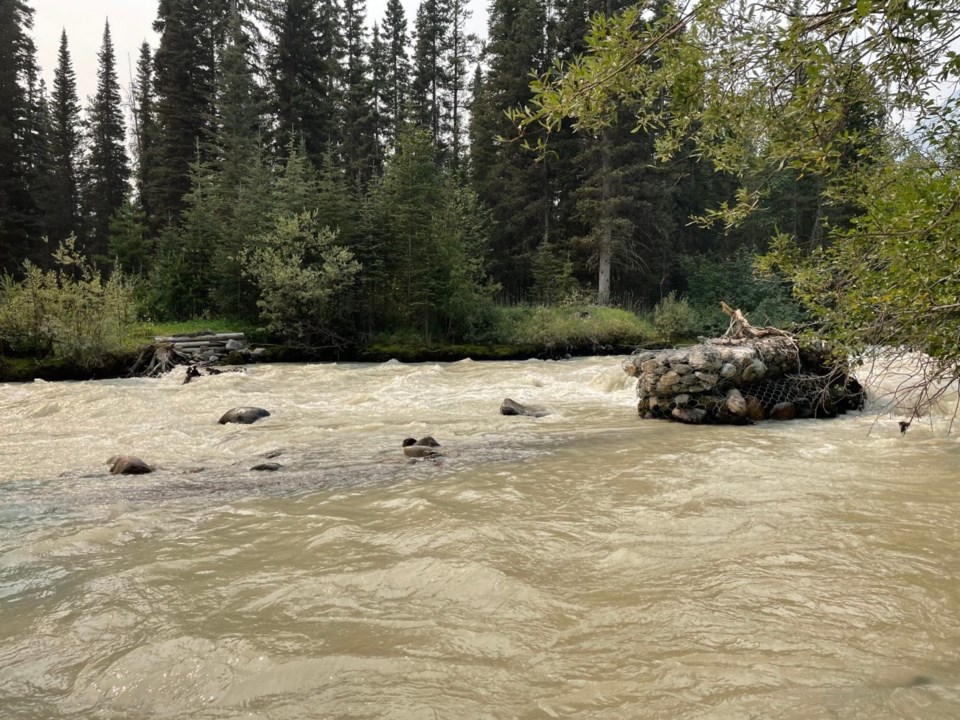Scott Hayes | [email protected]
Local Journalism Initiative Reporter
It has been several years since the Simon Creek bridge was taken out by the forces of nature, and Parks Canada has no plans to replace it at this time.
This is irksome to some, including some avid trail users in Jasper National Park. A on the Jasper Local's website delved into the proposal of a Calgary engineer who reportedly designed a 30.5-metre long and 1.8-metre wide fibreglass replacement bridge, consistent with Parks Canada's technical specifications.
On top of all that, he was offering it to Jasper National Park at no charge. It would come completely funded by private donors to the tune of $300,000. It would have set a unique precedent.
Supt. Alan Fehr declined the offer, citing other infrastructure needs in the park. The fact that Jasper National Park has approximately 1,000 built assets highlights that challenge.
Acting Superintendent Dave Argument says that it's heartening to witness people's passion for the park. Without trying to diminish the offer of a free bridge, ultimately the decision is a matter of how infrastructure usage weighs on the scale.
"It's a fairly complicated subject, of course, and I think perhaps more complicated than what is readily understood by some of the interested parties," he said.
The 51���� published a letter to the editor on May 18 wherein the local writer even speculated that the denial was a sign of how Jasper National Park has "changed its focus from inspiring people with wilderness to silently promoting commercialism."
"This looks like an offer of free money, but really, there isn't anything that comes for free," Argument said, paraphrasing Fehr from the Jasper Local piece.
"I think what perhaps people don't recognize is that this comes with a number of additional costs from the maintenance costs to an expectation of a higher level of service across the rest of the trail, whether that's campground maintenance further up the Athabasca Pass Trail, trail maintenance to a to a higher standard... those sorts of things. There's a whole bunch of other considerations."
The commitments that were made in the are not the least of those other considerations.
Objective 1.1 of that plan states that large areas of the park are to be managed as wilderness, where minimal facilities and low levels of human use contribute to providing the habitat requirements of wide-ranging species.
Canada's National Parks Act also prioritizes ecological integrity.
"We have to consider those things in all of these decisions,” Argument said.
“Opening up access to areas of wilderness or making access easier in some of these areas of wilderness could have unintended consequences down the road as well."
He confirmed that the Athabasca Pass Trail, along which Simon Creek flows, is open. It is not a high wilderness route.
"It's a seldom traveled route and always has been. It wasn't a popular route even when the old Simon Creek bridge was before the washout happened. It's simply not high on the priority list right now because of those factors."
Argument said that tracking backcountry campground bookings and trail counters – box-like devices attached to trees that record traffic numbers – helps Parks to understand which areas get more usage. This area just doesn't measure up against other trails.
"It seems like a fairly small group of people with a passion and interest in the Simon Creek bridge," he said.
Argument added that Jasper National Park is a very large park at more than 11,000 square kilometres and Parks Canada maintains more than 1,100 kilometres of trail, including hundreds of river crossings.
Of those crossings, there are 30 bridges that are of sufficient classification that they require engineered design, code specifications, annual maintenance and frequent inspections. These are called Class A bridges, and the Simon Creek bridge with its notable span and height would be one of them, Argument said, citing Parks Canada's Trail Priority Matrix.
That matrix guides decision-making in Parks Canada's capital investment in backcountry assets to make sure that its limited resources are used to their best effects.
"When we make decisions about where the trail crew is spending their time, what bridges are maintained, what bridges are replaced, it's guided by this trail matrix, which helps us prioritize those decisions. It's focused first and foremost on the trails that see the highest use, that are the most heavily impacted, or are the most iconic and significant trails in the park."
For those who hope to help Parks Canada manage its trails in the future, Argument suggested that they become involved with the . The two organizations have a longstanding relationship that is very positive and definitely valued, he said.
"What I think would be interesting would be to consider whether or not this kind of offer of volunteer time and interest would be better placed in working with the Friends of Jasper, who work with us under that Trail Prioritization Matrix to work on the trails that are identified as the highest priority," he said.
"It's not an easy thing to turn down the offer of free work or volunteer time, but it would be something to consider that we really need to focus that on the priorities that have been identified in that Trail Priority Matrix and under the guidance of the Park Management Plan rather than one-offs or special interests from the individuals."




